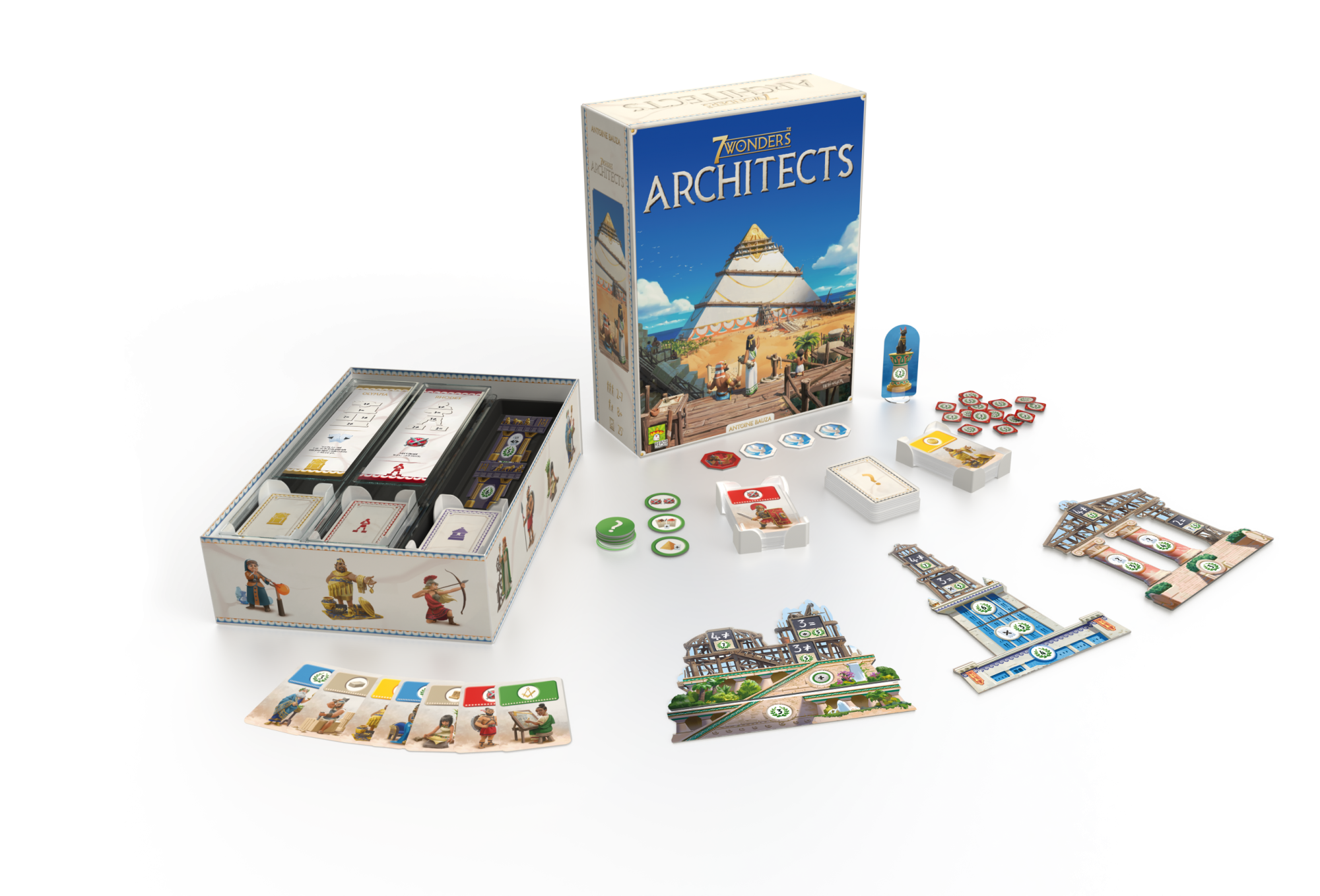I had expected 7 Wonders: Architects to be a streamlined version of the base game designed for a wider audience, like Simply Catan vs. Catan (e.g., fewer victory points, fewer cards, nicer components). In fact, 7WA is a dramatic reinvention of the game for the mainstream market, with gorgeous components. The result is a great game to give as a gift but probably not a great game to replay.
Differences from 7 Wonders—
- Easier to set up: 7WA is far easier to configure. Each wonder has its own self-contained plastic box and its own deck of cards. Gone is the need to sort through three ages of cards and remove the cards that don’t fit your number of players!
- Wonders are physical: The wonders are delightful bits of cardboard. On one side, they are shown “under construction”, then over the course of the game you build them up a piece at a time. This is visually stunning and far more rewarding than tucking cards under your player’s mat.

- Cards are greatly simplified: No card has a prerequisite or cost, so every card can be played. Instead of 12 types of yellow cards, there is one yellow card, which acts as a wildcard resource. Instead of 13 types of blue cards, there are two blue cards. And so on.

- Cards are spent: In 7 Wonders, if you want to build a card that requires brick and stone, you can do that for free if you have brick and stone resource cards in front of you; those cards are never used up. In 7WA, to construct each stage of your wonder, you spend cards instead, turning in 2, 3, or 4 cards (either all the same or all different, depending on the stage of the wonder). Green cards are spent for progress tokens. The only cards you keep for the duration of the game are blue cards and certain red cards.
- Drawing instead of drafting: You can draw a card from one of three places—from a facedown pile in the center, from the face-up deck to your left (the cards from your own deck) or from the face-up deck to your right. If you have the cat statue, you can peek at the facedown card and decide whether or not to draw it (the last player to draw a 2 VP blue card, which has a cat icon on it, takes the cat statue).
- Ageless: Instead of three separate ages, you play until one person completes their wonder, at which point the game immediately ends (even if they went first).
- Randomly timed battles, with casualties: In 7 Wonders, at the end of each age, you see how the size of your military compares to your neighbors and take bonus or penalty VPs as appropriate. In 7WA, battles are resolved when three dove icons have been flipped to the war side (caused by a horn icon on a played card; warriors have zero, one or two horns); winners take 3 VPs (typically) and then all warriors with horn icons are discarded.
- Science: Spend two matching (green) science cards, or three different science cards, to choose a progress token. These give you power-ups like additional draws when you play certain cards or victory-point bonus conditions.
- Works better with two players and worse with six or seven: It’s fiddly in the original 7 Wonders to play with two (you set up a third, neutral player). No need for that here. The game plays great for two. However, where play is simultaneous in 7 Wonders, making it a great game for six or seven players, play is sequential here.
- Engine building: The lack of prerequisites for cards mean you aren’t chaining cards over time and only a few of the progress tokens give you the ability to create an engine.
Game decisions are primarily tactical rather than strategic but there are interesting decisions to be made. With two players, games take about a half hour. I played eight games, to experience each wonder at least once. Giza is the least interesting wonder, as in the original: it only provides VPs. Babylon is the most interesting wonder, as it provides two progress tokens for two of its stages, which give the most interesting choices.
This is a great game for two to seven young or casual players, but probably is too tactical for avid boardgamers. That said, I’ll be buying a few copies for Christmas, as the game is delightful to experience.
Photographs copyright 2021 by Asmodee, publisher of 7 Wonders: Architects.



You must be logged in to post a comment.